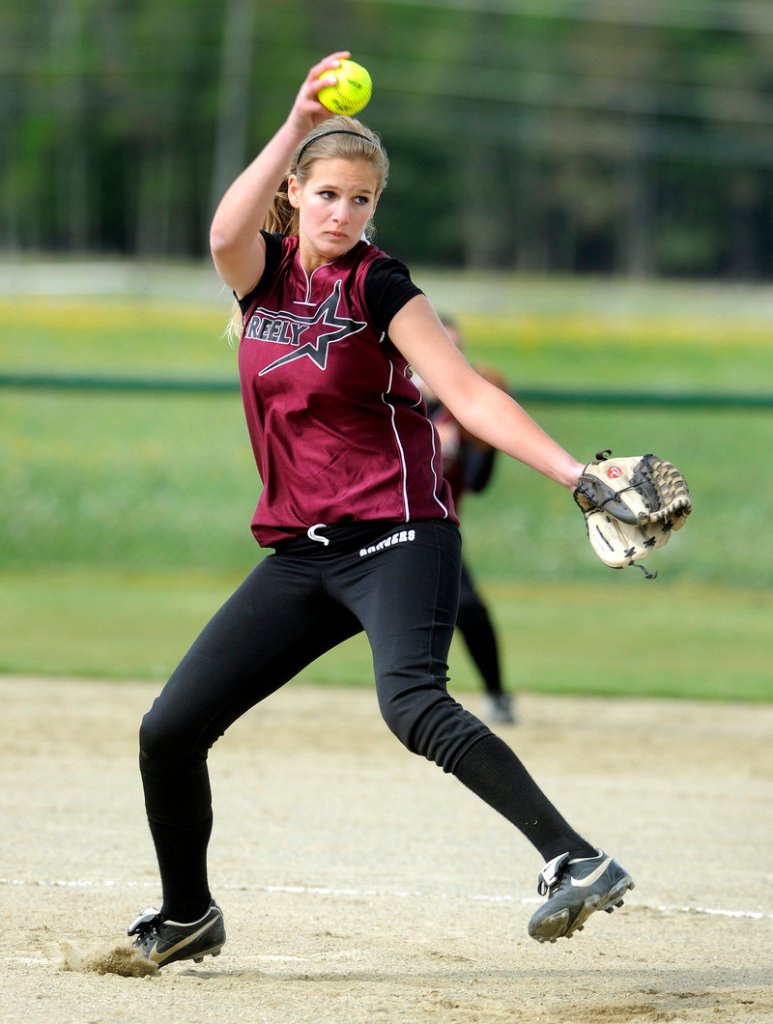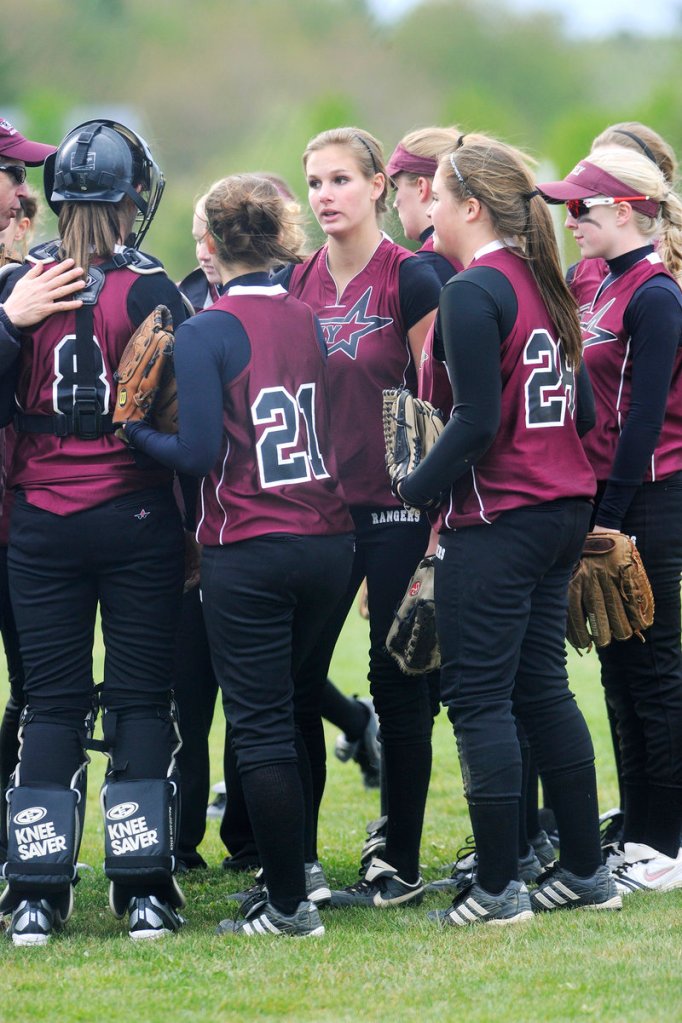CUMBERLAND – Mary Zambello has heard the taunts. She’s listened to nasty messages on the answering machine at home. She’s had coaches tell her she can’t compete on their team.
Mary Zambello has learned to ignore those who are telling her what she can’t do.
She’s the starting pitcher for a Greely High softball team that has an 8-1 record. She played the middle for the Rangers’ state champion volleyball team.
To see her pitch, with her economical delivery, one would get the impression that Zambello is your typical 18-year-old high school senior. To listen to her story would suggest otherwise.
Zambello was born with a tumor growing inside her spine. She’s undergone two surgeries and proton beam treatment, and has an MRI every six months to a year to make sure the tumor hasn’t returned.
“I’ve been her teammate for three years,” said Marika Stayte, Greely’s senior center fielder. “She is just so amazing. No matter what happens, she keeps her head up.
“She’s overcome a lot in her life. It shows how much heart she has and how much strength she has to be as good a pitcher as she is right now. She’s definitely the heart of the team. We rely on her all the time.”
That Zambello can play at all is a testament to her resiliency. Her mother, Lindsey Rustad, said, “We didn’t even know if she was going to walk.”
Zambello was 2 years old when her parents, Lou Zambello and Rustad, became concerned. She was having difficulty walking, limping on a left leg that was slower to develop than her right. After several doctor’s visits, an MRI revealed a tumor growing inside her spine. She was rushed to Massachusetts General Hospital in Boston, where the benign, slow-growing tumor was removed.
The limp remained, and the leg still grew at a slow rate. Today, her left leg is 1 1/2 inches shorter than her right leg and she walks with a limp.
When she was 9, an MRI revealed that the tumor had returned. Zambello had a second surgery to remove the tumor. But Zambello developed acute aseptic meningitis during recovery and spent the next two weeks isolated, unable to tolerate light or sound.
A year later the tumor returned. A third surgery wasn’t an option because of fear she would contract meningitis again. So doctors tried a new technique: proton beam radiation therapy. Five times a week, for eight weeks, Zambello went to Boston, going to school in the morning, with treatment at night.
She had to lie still for 45 minutes to an hour while proton beam radiation targeted the specific area of her spine when the tumor kept growing.
“She never complained,” said her mother.
The treatment seemed to work. Still, Zambello has to go to Boston every six months to have an MRI to make sure the tumor hasn’t returned.
Over the years, doctors have cautioned her as to physical activities. Snowboarding, a favorite activity, is out.
“And in volleyball they tell me to be very cautious about diving,” said Zambello. “But I still do it because to me, it’s just instinct. If the ball is going to drop, I have to go for it. I try not to limit myself too much.”
Zambello has played softball since second grade, volleyball since she was 12. She had to learn to pitch because that’s the only position she could play on the softball diamond. She’s still self-conscious over her limp and running style, and that prohibits her from hitting.
“But,” she said, “I love the games. Volleyball is definitely a love for me. I love softball, especially pitching, being in the middle of it all. I wasn’t going to let anything stop me.
“My family is very athletic. I just didn’t want it to beat me. I wanted to push through and compensate for it and do what I needed to do to compete at this level.”
Her father, Lou, said the teasing Mary took as a child and teenager spurred her on. “Kids called her lobster leg,” he said. “She got teased a lot. So part of this is her determination to show kids that she was going to be able to do whatever they could do. She doesn’t use it as an excuse; she doesn’t even think about it.”
He said the only frustration occurred when coaches told his daughter she couldn’t play on their team because of her limp.
“At Greely, we’ve been fortunate to have coaches who have defined her by what she can do, not by what she can’t do,” he said. “Unfortunately there were some who weren’t like that.
“Too often in tryouts, coaches look at how high you jump and how fast you run. They don’t think about how quickly you’ll react in the spur of the moment in a game. A lot of it isn’t just about moving quickly, but thinking quickly.”
Today, the left leg is shorter and weaker than the right leg. Its muscles don’t respond as well.
As a pitcher, the left leg is her landing foot. That’s the leg that should be the stronger of the two, generating much of the power in a pitcher’s wind-up.
Zambello doesn’t take a large stride with her left leg, unlike other pitchers who generate a lot of force – and with that, a faster pitch. “I don’t get as much drive as other pitchers,” said Zambello. “I try to work on other things that keep my speed up.”
She throws a fastball, drop pitch, change-up and screwball. Mixing speeds keeps the batters guessing. It’s worked so far. She’s 23-9 in her high school career. While not a big strikeout pitcher, she averages nearly four per nine innings. She has good control – only 15 walks in 46 innings this year.
“Mary learned to use what she had,” said Lou Zambello, who spent many nights last winter catching his daughter during indoor workouts. “She’s got big hands so the ball spins in it, creating movement. She’s played to her strengths. And she’s done a lot of it on her own.”
She also had to adjust in volleyball. Unable to jump off her left leg, she learned to jump off her right.
“It’s been a privilege to watch what’s she done,” said Rustad. “She’s always done it with a good attitude. She wasn’t going to let this get her down.”
Now doctors are watching a new development. Zambello has what’s known as a tethered spine. Instead of moving freely in spinal fluid within the spine, Zambello’s spinal cord has attached to one side of the spine. That leads to muscle weakness and nerve damage – symptoms that Zambello deals with daily.
Her competitive playing days probably will end when Zambello joins her older sister Erika at Cornell in the fall. She plans to study interior design/interior architecture. She hopes to play on a club team but will wait on that.
“I definitely want to be involved in some way,” said Zambello. “I try not to limit myself too much.”
She never has.
Staff Writer Mike Lowe can be contacted at 791-6422 or at:
mlowe@pressherald.com
Send questions/comments to the editors.





Success. Please wait for the page to reload. If the page does not reload within 5 seconds, please refresh the page.
Enter your email and password to access comments.
Hi, to comment on stories you must . This profile is in addition to your subscription and website login.
Already have a commenting profile? .
Invalid username/password.
Please check your email to confirm and complete your registration.
Only subscribers are eligible to post comments. Please subscribe or login first for digital access. Here’s why.
Use the form below to reset your password. When you've submitted your account email, we will send an email with a reset code.